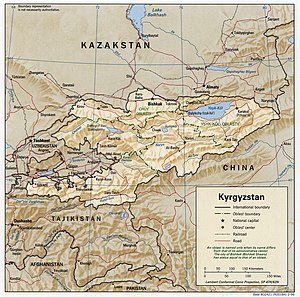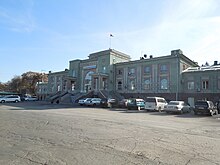Kyrgy's Temir Dscholu
| Кыргыз Темир Жолу
|
|
|---|---|
| legal form | Closed joint stock company |
| founding | 1992/1994 |
| Seat |
Bishkek , Kyrgyzstan |
| management | Argynbek Dschumabekowitsch Malabaew (since April 2010) |
| Number of employees | <5,000 (2017) |
| Branch | Railway company |
| Website | www.kjd.kg |
Kyrgys Temir Dscholu (KRG) ( Kyrgyz Кыргыз Темир Жолу ; Russian Кыргызская железная дорога ; German Kyrgyz Railway ) is the state railway of Kyrgyzstan . It operates passenger and freight traffic.
Geographical requirements
95% of the area of Kyrgyzstan is mountainous. This partly explains why the country has only a few hundred kilometers railway line and the existing routes spurs are that lead from abroad to Kyrgyzstan in and which do not connect within the country. The construction of any long connection within Kyrgyzstan is costly due to the country's topography .
history
The route network of the Kyrgyz Railway was created at the time when Kyrgyzstan was part of the Soviet Union . The routes built at that time took no account of the course of the border between Kyrgyzstan and neighboring republics. As a result, it now consists of four sub-networks that are not connected to one another on Kyrgyzstan and represent island operations .
As the first in the territory of Kyrgyzstan, the line between Lugovoi and Bishkek (then: Pischkek ) was opened on August 8, 1924 . The line from Bishkek to Balyktschy (then: Rybachye ) was extended until 1948, and operations there began in 1950.
With the expansion of the Trans-Caspian Railway , four branch lines coming from Uzbekistan were extended to Kyrgyzstan (see section route network ).
In 1992 Kyrgyzstan became independent and the Northern Railway was constituted by Presidential Decree as the Kyrgyz Railway. In 1994 the southern branch lines, insofar as they ran in Kyrgyz national territory, were transferred from Uzbekistan to Kyrgyzstan and also placed under the Kyrgyzstan railways. The state railway has existed since 2005 - also due to a presidential decree - under its current name. These southern routes are combined in a separate administration.
Route network
The Kyrgyz Railway operates its routes in the Russian broad gauge of 1520 millimeters. The network covers a route length of 427 km, which is spread over four routes that are not interconnected:
- (Lugowoi) - Kajyngdy - Bischek - Balyktschy , approx. 263 km. Lugovoi – Bishkek railway line , opened in 1924. It is the only line in the northern part of the country and at the same time the longest and most important line, as well as the only one on which there is also passenger traffic.
- ( Fargʻona ) - Kysylkyja , 6 km, opened in 1926.
- ( Qoʻrgʻontepa ) - Karasuu - Jalalabat - Kok-Dschangak , 29 km, opened in 1932 with the branch
- Karasuu - Osh (1932), 7 km, opened in 1932.
- ( Utschkurgan ) - Schamaldysai - Taschkömür , opened in 1935.
vehicles
When the former Soviet railways (SŽD) were divided up by the CIS , Kyrgyzstan received 1,644 freight cars , of which 317 are still in operation today, 450 passenger cars and 50 diesel locomotives . The number of vehicles has decreased due to the decline in freight and passenger transport services. 367 passenger cars are currently still in service. They have been overhauled since 2008, 65 of them recently in Tashkent in order to upgrade them for a service life of 41 years.
In 2013/14 six new diesel locomotives of the series ТЭ33A (TE33A) were ordered and have since been delivered.
business
Timetables
Operations are carried out analogously to the Russian State Railways after Moscow time . All timetables and station clocks show the time in the Russian capital.
passenger traffic
Passenger traffic plays only a very minor role. In the south of Kyrgyzstan it was completely discontinued and in the north the number of trains was greatly reduced. In the last 25 years it has decreased by 85%. In 2017, the train counted 313,000 passengers, 27,100 of them on international traffic.
Passenger trains run all year round only between Lugovoi ( Kazakhstan ) and Tokmok , long-distance trains between Bishkek and beyond Lugovoi. During the summer season there are also trains between Bishkek and Balyktschy at the western end of Lake Issyk-Kul . The routes in the southern part of the country are only served by freight traffic. The following connections are offered in international traffic (2017):
- Bishkek - Moscow , twice a week,
- Bishkek - Kazan , once a week,
- Bishkek - Novokuznetsk , once a week.
The number of travelers is declining and passenger traffic is in deficit. Annual passenger losses are half a billion som . The state maintains it through grants. Since 2014, attempts have been made to counteract the drop in passengers with cheaper tickets in advance sales. Fares have not increased since 2010.
Freight transport
After the independence of Kyrgyzstan, industrial production in the country fell by 70 percent. After 1991, the volume of goods on the Kyrgyz Railway also fell to the same extent. The main goods transported are non-ferrous metals, coal, cotton, cement, grain, sugar and petroleum products. The railways have a transport share of 40% in export and 70% in import.
Transportation services
| Art | 1990 | 1992 | 1993 | 1994 | 1995 | 1996 | 1999 | 2000 | 2002 | 2007 | 2010 | 2017 |
|---|---|---|---|---|---|---|---|---|---|---|---|---|
| Goods transported in million t | 8.0 | 5.5 | 3.0 | 1.4 | 0.9 | 1.3 | 1.0 | 0.9 | 2.6 | 6.9 | 5.5 | 7.2 |
| Freight transport performance in million tkm | 2619.6 | 1588.9 | 923.0 | 628.9 | 402.6 | 480.0 | 353.8 | 338.0 | 332.0 | 848.7 | 737.7 | 935.0 |
| Persons transported in millions | 1.4 | 1.7 | 2.3 | 1.1 | 0.8 | 0.9 | 0.4 | 0.6 | 0.6 | 0.44 | 0.71 | 0.31 |
| Passenger transport performance in million people km | 205.0 | 234.9 | 295.3 | 172.4 | 87.0 | 91.8 | 31.3 | 44.2 | 50.0 | 59.9 | 98.7 |
Planning
Connection to the Chinese railway network
As part of the “ New Silk Road ”, a railway line is to be built from the city of Kashgar (Kaxgar) in northwest China to the southwest Kyrgyz city of Karasuu, which in turn will provide a connection to the Uzbek network. The route would have a length of 270 km and lead over the Turugart Pass , the Tuzbel Pass, the Arpatal and Ösgön to Karasuu. The route mainly leads through high mountains, which necessitates numerous engineering structures : 48 tunnels 49 kilometers in length and 95 bridges 21 kilometers in length. The costs are estimated at more than US $ 2 billion and are to be raised by both government and private investors.
The following effects and advantages should be associated with the construction of the railway line for Kyrgyzstan:
- improved development potential in foreign trade
- accelerated economic integration and close cooperation between the Central Asian states
- Promotion of tourism
- Access to the Chinese ports
- industrial and economic development of the Fergana Valley
Electrification of the Lugovoi – Bishkek
The electrification of the northern route of Kyrgyzstan is to increase its maximum speed from 60 km / h to 120 km / h, the average speed for passenger trains from 33 km / h to 70–80 km / h and for freight trains to 90 km / h. The advantage of electric traction is that diesel fuel, which has to be imported, can be saved and electricity generated from domestic hydropower can be used instead.
Connection between Balikchy and Jalalabat
In order to connect the northern route - and thus the capital - to the southern part of the country by rail, a more than 350-kilometer-long railway line between Balikchy and Jalalabat has been planned for a long time. It is also developing rich coal deposits in the Naryn area . However, there do not seem to be any concrete plans.
Worth knowing
- The state railway is one of the largest companies in Kyrgyzstan and employs more than 5,000 people and is one of the companies in the country with the highest tax revenue.
- She has been a full member of the Organization for Cooperation of Railways (OSJD) since 1995 .
literature
- Н.П.Лагутина, Т.Ю. Набокова, Т.П. Филатова: Атлас Железные Дороги . Omsk 2010.
- Zhamshitbek Kalilovich Kalilov: Status and Development Prospects of "Kyrgys Temir Zholu National Company" . In: OSJD Bulletin 2/2018, pp. 1-7.
Web links
Remarks
- ↑ So: Kalilov: Status , p. 4. This amount corresponds to about 6 million euros.
Individual evidence
- ↑ Kalilov: Status , p. 1
- ↑ Kalilov: Status , p. 1
- ↑ History of the Central Asian Railway ( Memento of the original from January 6, 2011 in the Internet Archive ) Info: The archive link was automatically inserted and not yet checked. Please check the original and archive link according to the instructions and then remove this notice. .
- ↑ Kalilov: Status , p. 3.
- ↑ So: Kalilov: Status , p. 1, according to Лагутина: Атлас , Pl . 85, 87, but the length of the route should be less than 300 km.
- ↑ Information according to: Н.П.Лагутина u. a .: Атлас , plate 85 a. 87.
- ↑ Kalilov: Status , p. 5.
- ↑ Kalilov: Status , p. 3f.
- ↑ Kalilov: Status , p. 6.
- ↑ Kalilov: Status , p. 3.
- ↑ Kalilov: Status , p. 4
- ↑ Kalilov: Status , p. 3.
- ↑ Kalilov: Status , p. 4
- ↑ Kalilov: Status , p. 5.
- ↑ Kalilov: Status , p. 4
- ↑ Kalilov: Status , p. 1
- ↑ Homepage of welcome.kg .
- ↑ OsshD-2002: Journal of the OsshD, Volume 47, 2004, p. 37
- ↑ General overview of rail traffic in the states of the OSJD 2010 ( Memento of the original from January 16, 2014 in the Internet Archive ) Info: The archive link was automatically inserted and not yet checked. Please check the original and archive link according to the instructions and then remove this notice.
- ↑ Kalilov: Status , p 3; 5.
- ↑ United Nations: Priority investments in the future for the development of the Trans-Asian railway network ( Memento of the original from January 20, 2012 in the Internet Archive ) Info: The archive link has been inserted automatically and has not yet been checked. Please check the original and archive link according to the instructions and then remove this notice. (English; PDF; 987 kB)
- ↑ Kalilov: Status , p. 7.
- ↑ See: Kalilov: Status , p. 7.
- ↑ Kalilov: Status , p. 3.
- ↑ Kalilov: Status , p. 7.
- ↑ Kalilov: Status , p. 1




